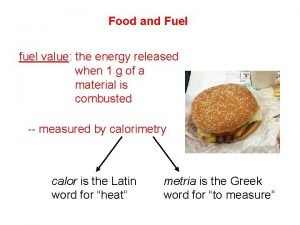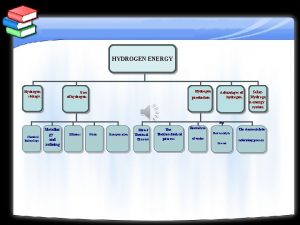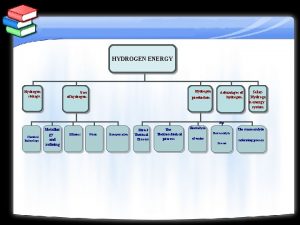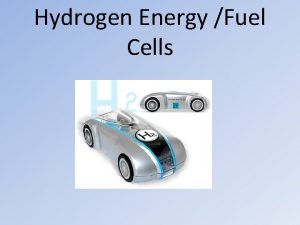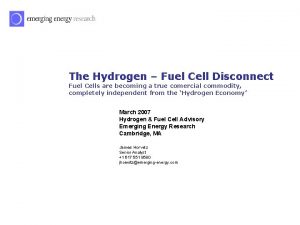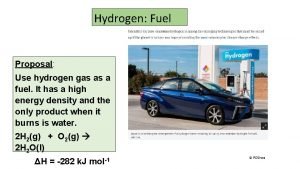HYDROGEN FUEL CELLS CURRENT AND FUTURE DESIGNS USE










- Slides: 10

HYDROGEN FUEL CELLS CURRENT AND FUTURE DESIGNS USE AS AN ENERGY STORAGE DEVICE RENEWABLE VS. CO 2 GENERATING DISTRIBUTION METHODS AND COSTS SAFETY

Molecular Hydrogen Facts • Three times energy content of gasoline (120 Mj/kg vs. 44 Mj/kg) • Cost of liquefying it is 30 to 40% of its energy content • Pipelines are 50% greater diameter than for gas (for equivalent energy transmission rate), so more $. • Distribution doubles cost of production ($1. 03/kg). • Flammable concentration has a wide spread from 4% to 75%.

Types of Fuel Cells • Phosphoric Acid fuel cells: only commercially available. Since 1991, 250 units sold (until 2004). $4500/k. W • Proton Exchange Membrane fuel cells. Vehicle transportation method because 25 k. W to 150 kw size. Beta testing at $1500/k. W by UTC Fuel Cells. • Solid Oxide fuel cells. Currently operate using natural gas, but could use H. Unlike those above, no noble metals. Can operate up to 1000 c.

Molecular Hydrogen Generation • Three different scales of generation: Central Station, Midsize, and Distributed. • Central Station: 1, 080, 000 kg/day would support 2 M cars. Distributed by pipeline. Generated by fossil fuel or nuclear energy. • Midsize: 21, 600 kg/day would support 40 k cars. Distributed by cryogenic truck. Generated by natural gas or biomass • Distributed: 480 kg/day would support 800 cars. No distribution system needed. Renewable fuels used.

Hydrogen Generation • Electrolysis: from fossil fuels or renewable energy sources • Fossil Fuels requires carbon sequestering (next slide) • Hydroelectric, Nuclear Energy, Photovoltaic, grid based energy, wind power, have either periodic generation, which may not match usage, or have constant generation, which does not match usage. • Energy storage at peak times is a problem for these energy sources that hydrogen generation could solve. • Cost for all distributed (renewable) sources is two to five times cost of gasoline (2004)

Carbon Dioxide Sequestering • No advantage to Hydrogen production from fossil fuels as far as reducing Carbon Dioxide is concerned. Yet this is the cheapest method to generate Hydogen. • Currently, only 4% of Hydrogen is from electrolysis; the rest is from coal, oil and natural gas, which contains about 10% CO 2 as well as the Hydrogen. • Norway injects CO 2 into saline aquifer. • Los Alamos study of CO 2 injection into magnesium formations (Peridotites, serpentinite, Gabbro, and Basalt) • Costs about $8 per ton of CO 2 disposed. Permanent and no legacy problems for future generations.

CO 2 and Hydrogen from fossil fuels • Small increase in cost to capture CO 2 when hydrogen produced by fossil fuels. • Using coal as feedstock, sulfur captured along with CO 2. • CO 2 sequestering and storage costs about $4. 00/barrel of oil, $24/ton of coal, $0. 54/cubic feet of natural gas. • New infrastructure required to transfer CO 2 from H 2 production to storage. • Deep ocean already stores CO 2, may give it up with warming. • World’s biological storage now 700 billion tons. To double this storage would require doubling vegetation.

Hydrogen production technologies • From natural gas. Already import natural gas. H conversion from methane by steam reforming, produces CO too. If natural gas costs $6. 50/Btu, H costs $3. 51/kg • From Coal. Enough to last 200 yrs. Produces the most CO 2 for the same H. Gasification produces syngas. Research may get costs to $0. 90/kg. • From nuclear energy. Water splitting by electrolysis or thermochemical process. Need temps of 700 to 1000 c. No CO 2. No cost estimates. • Electrolysis. Most expensive. Use proton exchange membrane( PEM) or liquid electrolyte (KOH).

Hydrogen production--Renewable fuels • From wind energy. Electrolyze water. Wind is the most cost effective renewable energy source: $0. 04 to $0. 07/k. Wh costs about $6. 64/kg per H 2 if grid back up used. • From Biomass. Only 0. 2 to 0. 4% of solar energy converted to H 2. Costs $7. 05/kg by gasification, not including fertilizers and land degradation. • From Solar energy. Either by electrolysis (Photo voltaic) or using photoelectrochemical cell (in a early stage of development). Cost now is $28. 19/kg and solar energy is only available 20% of the time.

Hydrogen safety • Small leak more flammable than for gasoline, but more likely to disperse, so ignition less likely. • Static spark can ignite, so ground during transfer. • Detonation more likely than with gasoline because of wider flammable concentration and higher flame speed. • Need high pressure to transfer efficiently: 5 -10 k psi. • Odorless, burns with a blue flame. Small molecule precludes adding scent molecule.
 Valuetheenergy.com
Valuetheenergy.com Future simple future continuous future perfect exercises
Future simple future continuous future perfect exercises Esercizi future continuous e future perfect
Esercizi future continuous e future perfect Paranasal sinus development
Paranasal sinus development Chlorocruorin
Chlorocruorin Venn diagram for plant and animal cells
Venn diagram for plant and animal cells Masses of cells form and steal nutrients from healthy cells
Masses of cells form and steal nutrients from healthy cells Trends of media and information
Trends of media and information Line current and phase current
Line current and phase current Phase to phase voltage
Phase to phase voltage Drift current and diffusion current in semiconductor
Drift current and diffusion current in semiconductor
